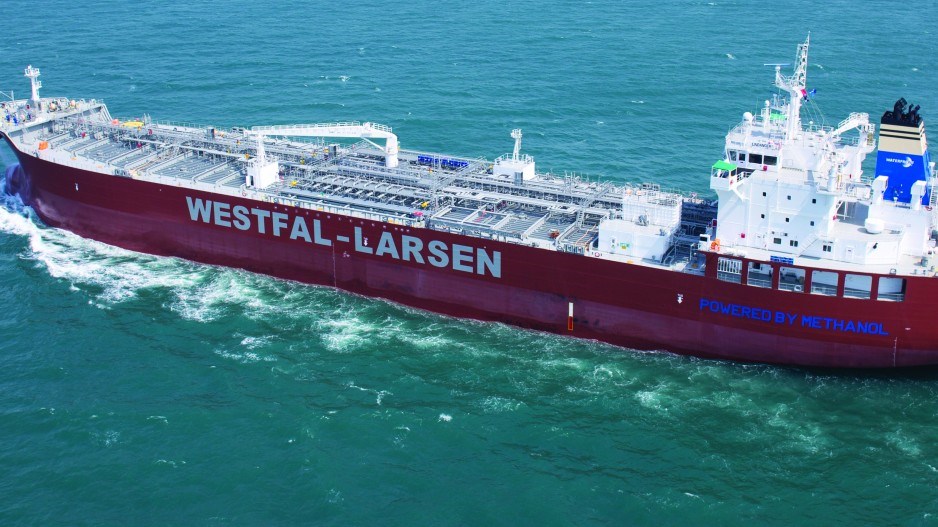International restrictions on bunker fuels burned by ships operating within North America’s 200-nautical-mile “emission control areas” are responsible for Metro Vancouver’s dramatic drop in SO2, and those restrictions will be expanded to all international shipping in the coming decade.
And that’s good news for one Vancouver company that has been capitalizing on the international regulations on emissions from shipping: Methanex Corp. (TSX:MX).
“That one change alone has been the key reason why air pollution in Vancouver has gone down 80%,” Jason Chesko, Methanex’s senior manager of global market development, said at the Gasification and Syngas Technologies Conference held last week in Vancouver.
Natural-gas-producing regions like B.C. stand to benefit from the trend of using liquefied natural gas (LNG), methanol and gasoline made from natural gas or synthetic gas made from waste as alternatives to gasoline and diesel made from oil.
Currently, B.C.’s policies have focused almost exclusively on developing a liquefied natural gas industry. But as speakers from Methanex and Air Liqiuide pointed out at the gasification conference, natural gas is also used to make methanol and can be used to make low-carbon gasoline. And market demand for both could be significant in the coming years as the world shifts to low-carbon fuels.
Methanol’s principal use is as a chemical precursor for products ranging from plastics and paint to adhesives and refrigerants. But its use as a fuel has been growing dramatically and now accounts for 40% of the methanol Methanex produces.
Methanex isn’t just the world’s largest methanol producer – it also has its own fleet of 25 deep-sea tankers for transporting chemicals and fuels.
Six of its ships have been converted to dual engines that can burn both methanol and heavy fuel oil. It plans to launch a seventh ship that can run on methanol in the coming weeks.
Chesko expects the use of methanol as a fuel to increase dramatically after 2025, when the International Maritime Organization (IMO), an agency of the United Nations, expands its regulations on emissions from shipping to more global levels.
The new regulations will force international shipping companies to either install scrubbers or start converting their ships’ engines to burn other types of fuel.
Although ship engines can be converted to run on other fuels – LNG, for example – Chesko said methanol is ideal because it contains no sulphur – one of the pollutants of most concern for human health. Methanol plants are also cheaper to build than LNG plants, and there is already a global network of methanol plants and receiving terminals in place.
“This is a small opportunity today, but the whole marine industry is going low-sulphur in 2020-25 and that’s a massive industry,” Chesko said.
“You’ve got regulations around the world that are continuing to get more strict on all energy applications, whether it be marine or power; people are requiring clean fuels, and methanol is an ultra-clean fuel.”
Another new fuel trend might be gasoline made from natural gas. Air Liquide Global E&C Solutions, Air Liquide’s engineering and construction business, has licensing rights for an Exxon Mobil Corp. (NYSE:XOM) methanol-to-gasoline technology that uses natural gas to produce gasoline that is sulphur-free and low in benzene – a crude oil byproduct that is carcinogenic.
“Everybody talks about LNG,” said Siva Ariyapadi, Air Liquide Global E&C Solutions director of technology sales for the Americas. “That is a good option, when you talk about large-scale monetization of gas.”
But, as he points out, LNG is capital-intensive and requires port access, whereas refineries could produce gasoline from local sources of natural gas for local markets without having to ship it.
And compared with an LNG plant or oil refinery, a gas-to-gasoline refinery would have a much lower capital cost. A large LNG plant costs $40 billion to $50 billion. Ariyapadi said a gas-to-gasoline plant would have a capital cost of less than $2 billion.
Air Liquide is offering the technology to project developers and natural gas producers that may want to use it to build a gas-to-gasoline plant somewhere in North America.
“This technology can be a viable option for converting abundant gas reserves in British Columbia and Alberta into a high-quality, sulphur-free gasoline product for domestic use,” Ariyapadi said.
To date, one gas-to-gasoline plant using ExxonMobil’s technology has been built in China and a second is under construction there. Air Liquide is hoping to find a partner willing to build one in North America.
B.C.-based Blue Fuel Energy also has plans for a gas-to-gasoline refinery. Blue Fuel’s Sundance Fuels refinery in Chetwynd would have an estimated capital cost of $2.5 billion.
Methanex has its own fleet of 25 deep-sea tankers for shipping chemicals and fuels | submitted




